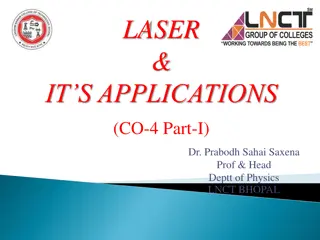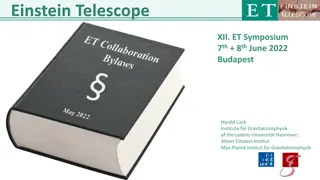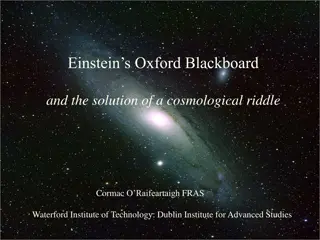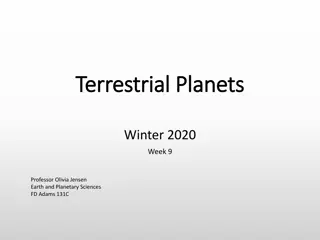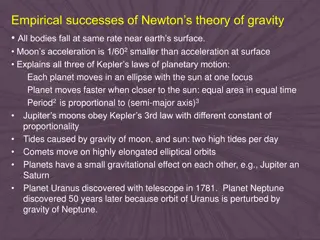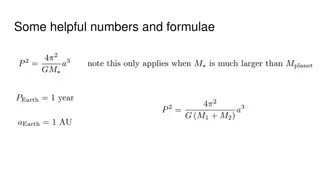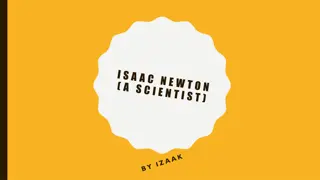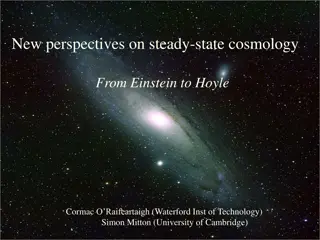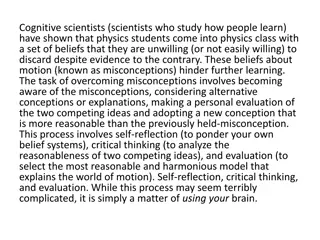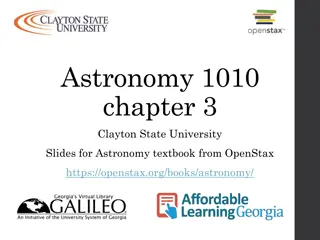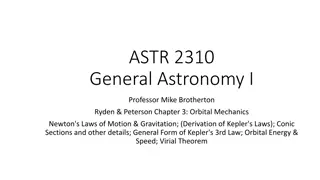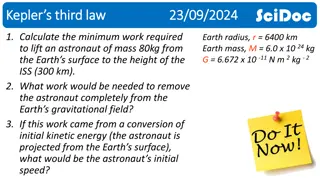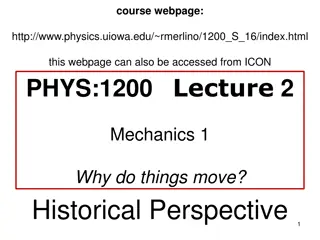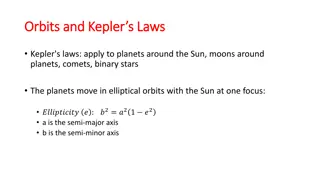Influential Scientists in History: Newton, Hawking, Einstein, and Kepler
Explore the remarkable contributions of influential scientists from different eras - Sir Isaac Newton, Stephen Hawking, Albert Einstein, and Johannes Kepler. Learn about Newton's laws of motion, Einstein's theory of relativity, Hawking's work on black holes, and Kepler's laws of planetary motion.
Download Presentation

Please find below an Image/Link to download the presentation.
The content on the website is provided AS IS for your information and personal use only. It may not be sold, licensed, or shared on other websites without obtaining consent from the author. Download presentation by click this link. If you encounter any issues during the download, it is possible that the publisher has removed the file from their server.
E N D
Presentation Transcript
Physicists and Astronomers Reach for the Top Evan Sauve
Sir Isaac Newton I was born on 1643. through a prism. I wrote a book in the same style as Euclid s Elements. My best-selling published work was Philosophiae naturalis principia mathematica, or Principia for short. I was interested in the attraction between Heavenly bodies but I had trouble making calculations for this; so, I invented calculus. I am well-known for theorising three laws of motion. An apple probably didn t fall on my head. I discovered that white light was made up of all the colours of the rainbow, as shown by shining white light
Newtons Three Laws of Motion Are: Newton s first law: A body continues in a state of rest, or motion with a constant velocity, unless compelled to change by an unbalanced force. Newton s second law: The acceleration of an object is directly proportional to the net force acting upon it and inversely proportional to its mass. Newton s third law: For every action force, there is an equal and opposite reaction force. 1. 2. 3.
Stephen Hawking I was born in 1942. scientist, I may be better-known because of my motor neurone disease related to amyotrophic lateral sclerosis (ALS). Working with Roger Penrose, I developed theorems on gravitational singularities theorems in the framework of general relativity. Because of this disease, I was eventually almost completely paralyzed and I communicated with a speech generating device. I was the first to unite the general theory of relativity and quantum mechanics. I discovered that black holes emit radiation. This radiation is now named after me. I wrote A Brief History of Time. Although I am a well-known
Albert Einstein I was born in 1879. I am probably the most famous scientist of all time. My trilogy was a set of three publications that came out in 1905. One deals with Brownian motion. Another deals with the photoelectric effect. I received a Nobel Prize for this in 1922 (even though it was the Nobel Prize in Physics of 1921). The third deals with the special theory of relativity. My greatest publication came out in 1915. This was about the general theory of relativity. This publication postulated that gravity and acceleration are the same thing. I told the world that energy is equivalent to the product of mass and the speed of light squared. e = mc2
Johannes Kepler I was born in 1571. describing the movement of planets around the Sun. Most of my work is the continuation of Copernicus (who realised that the Church was wrong, and that our solar system was heliocentric, not geocentric). Today, these discoveries are known as my Three Laws of Planetary Motion. I was the assistant of Tycho Brahe. Brahe was afraid that I would eclipse him as the premier astronomer of the time, so he told me to only study Mars. From my studies of Mars, I developed my three laws
Keplers Three Laws of Planetary Motion Are: Planets revolve around the Sun in an elliptical path, with the Sun occupying one of the foci of the ellipse. Straight lines joining sun and planet sweeps out equal areas in equal intervals of time. Squares of planets' orbital periods are proportional to the cubes of the semimajor axes of their orbits. 1. 2. 3.
Galileo Galilei I informally stated the principles that were later embodied in Newton s first two laws. I invented the first mechanical pendulum clock, improved the telescope and developed the first thermometer. My work dealt with topics including falling bodies, magnets, the tides, compasses and the arc of cannonballs. I was the first to use a telescope to collect evidence that the Earth revolved around the Sun. Because of this, I spent the last eight years of my life under house arrest in Rome (because this idea was not accepted by the Church). I discovered four moons of Jupiter, including Europa and Io. You may recognise my name as it is sung twice in a row a few times in Queen s Bohemian Rhapsody .
Edwin Hubble I estimated when the Big Bang was before the theory was theorised. I estimated it was at least 2 billion years ago. (We believe it now to be closer to 13.7 billion). away, it is moving faster away from us than the closer ones. This also goes for galaxies (like Andromeda) that are moving closer to us. You probably know my name from the space telescope that orbits the Earth and takes pictures. I realised that other galaxies must exist, since Andromeda was too far away to be in the Milky Way. The idea of redshift helped me develop my law. My law states that galaxies move away from each other at a rate dependent to the distance between them. In other words, if a galaxy is far
Clerk Maxwell I was born in 1831. Maxwell-Boltzmann kinetic theory of gases, which I developed independently of Ludwig Boltzmann. Einstein described my work as "the most profound and the most fruitful that physics has experienced since the time of Newton. I proposed the phenomenon of light is an electromagnetic phenomenon. I developed a theory that showed that molecules at high temperature have a high probability of moving toward those at low temperature. This theory is known as the



